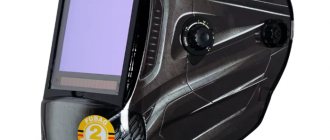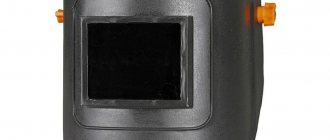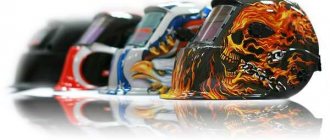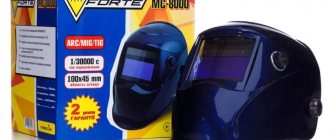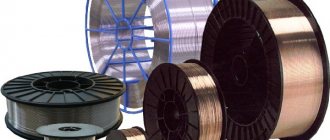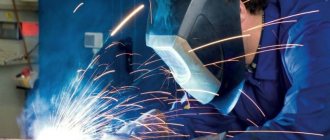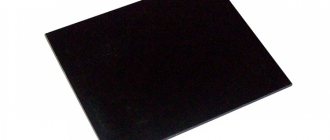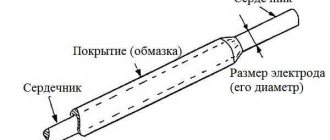Welding glasses are designed to comply with safety regulations when carrying out gas-flame processing of metals. A gas-electric welder is considered one of the most dangerous professions.
Welding glasses are necessary to protect the retina, cornea, and mucous membranes of the eyes.
The eyesight of a gas cutter who performs welding is at significant risk. Therefore, such an individual remedy is necessary to reliably protect the retina, cornea, and eye mucosa.
Adverse effects of welding on the organ of vision
Ten rules of welding.
- The high luminous flux of a burning bright arc of a welding machine is potentially dangerous for a professional’s visual organs, since it has an extremely unfavorable spectral distribution.
- With prolonged exposure to the pupil and cornea of the eye, this harmful factor in technological processes can lead to serious diseases.
- Often bright light spots, similar to “sunbeams,” flash before your eyes.
- In severe cases, temporary or complete blindness develops.
- The most dangerous injury to a welder is damage to the eyes from hot fragments, scale, and shavings of hot metal.
- A powerful welding arc produces intense ultraviolet and infrared rays. Their exposure can lead to the development of severe occupational cataracts.
- If, during the welding process, unprotected organs of vision were exposed to even short-term exposure to ultraviolet rays, fire sparks flying from the arc, splashes of molten metal, or solid technical particles entered the eyes, this can cause electrophotophthalmia - a dangerous burn of the conjunctiva and cornea of the eye due to welding.
- Severe injuries received by an electric and gas welder while performing work with hot metal are, in most cases, complex in nature. These are light, thermal, chemical damage to the eyes.
On the issue of interchangeability
Gas welding safety glasses cannot be used when welding with an electric arc. Firstly, the wave spectrum of the glow of an arc discharge is much higher than that arising from gas welding. Secondly, the arc glow spectrum is constantly changing, which is taken into account by liquid crystal self-regulating filters in popular models of Chameleon welding helmets. Lenses for gas welding glasses do not have such capabilities.
Thus, for electric welding work, where significantly higher radiation differences constantly occur, conventional gas welding safety glasses cannot be used. In cases where emissions of molten metal particles occur during gas welding, a conventional protective shield with light filters of the same characteristics as in welding glasses is used.
The “Chameleon” mask can be used for gas welding, but in practice this is not done: if only gas welding work is carried out, then the rather high price for the “Chameleon” is not justified.
Requirements for welder safety glasses
Chameleon glasses are equipped with high-quality light filters and an automatic darkening function.
Welder eye protection must comply with safety standards and requirements.
They have to:
- Protect your eyes from damaging factors: industrial dust, tiny hot metal fragments.
- Securely attaches to the head.
- Have high-quality light filters to reliably protect your eyes from harmful factors.
- Provide a wide view.
- Fit tightly to the skin surface of the face, but do not create excessive pressure. Therefore, it is advisable to try on eye protection devices for welders when purchasing to determine how convenient they are for work.
- Have folding glass to check the quality of seams.
- Maintain the ability of the visual organs to clearly distinguish small surrounding details.
- Have ventilation.
- Do not cause irritation or inflammation of the visual organs
- Do not be exposed to fogging.
- Be light in weight and have a thickness of standard lenses of at least 3 mm, special impact-resistant ones - from 2 mm. These devices automatically adjust the flow of light, so they have many advantages when welding in dimly lit areas. This is very convenient for a professional.
Nowadays, models of welding glasses have been developed that can be worn over glasses for vision correction.
If safety glasses for welding are chosen correctly, the welder will not have problems with his eyes when working with gas equipment. Chameleons are especially convenient for semi-automatic welding.
Application
As you know from the name, miracle glasses have found their application in the welding field. They are convenient to use when carrying out arc welding or semi-automatic welding. To do this, when buying glasses, you should pay attention to the degree of darkening; medium is enough (level 3 or 4). Please note that each type of welding has its own standards for shading welding glasses.
The main situations with the use of protective welding glasses are when it is necessary to apply a small (short) seam, and it is not possible to get close to it with a mask.
There is one strict rule: wearing glasses it is allowed to work with seams located no higher than the level of the chest.
This is due to the fact that with any welding method you can get injured from splashes and small particles of hot metal. When working with seams below chest level, the likelihood of injury is reduced, and it is almost impossible to get a facial burn.
It should be emphasized that it is recommended to use welding glasses when working with gas welding or when plasma cutting metal. It is not recommended to use them for electric welding. The reason is particularly strong radiation and a large area of scattering of splashes of metal particles.
Use of eye protection
The welder's glasses fully comply with safety requirements:
- The body of the glasses is made of flexible, soft, non-flammable plastic, which completely covers the upper part of the face and easily takes its shape.
- The glasses are held in place by an elastic band, the length of which can be adjusted.
- Ventilation is built into the top of the glasses. It is needed for air exchange and to prevent glass fogging.
- Glass protects the eyes from mechanical damage. Light filters protect the organs of vision from harmful light radiation from a very bright arc.
Reliable chameleon glasses
They got this name because they are equipped with high-quality filters and an automatic dimming function.
Goggles for welding with a folding glass holder - fit tightly to the face, are equipped with ventilation, and prevent tearing.
These glasses are the most practical and convenient protective equipment:
- Their main element is special transparent glass or lenses made from high-strength polymer material. They protect the gas cutter’s organs of vision from adverse damaging factors of operating gas equipment.
- Chameleon glass has a protective layer - a liquid crystal screen. During operation, polarization of the crystals occurs. If conditions arise that create risks for the organs of vision, the crystals line up in a certain sequence and reduce the number of passing light fluxes.
- Modern filters in gas welder glasses contain up to three protective liquid crystal layers.
- When there is a bright flash of the arc at the beginning of welding, they are lowered, protective filters are instantly activated, which darken as much as possible within one second. The response speed of sensitive light filters depends on the level of air temperature in or outside the room. The filter response time increases significantly when operating at low temperatures.
- Therefore, it is not recommended to work in glasses with an auto-filter at negative temperatures below 5-10°C, since a reliable degree of darkening will not be ensured by the light filters.
- There are some techniques you can use to solve this problem. In cold weather, you can work in such glasses if you keep them warm for a while. A warm filter will work faster and ensure safe operation of the gas cutter.
- Welding chameleon glasses are convenient for soldering small parts. This device can be purchased in online stores or specialized shopping centers.
- The advantage of such glasses is the ability to effectively protect the worker’s organs of vision from infrared and ultraviolet radiation, and the ability to instantly change the level of darkness during the formation of an electric arc.
About glasses
Working with a mask is often accompanied by a large load on the cervical spine, and when working in hard-to-reach areas, the mask is not always convenient, because to check the quality of the sutures you have to remove it, and this takes both effort and time. What can not be said about glasses. Due to their smaller size, they do not always need to be removed; you can simply slide them onto your forehead, and the unique feature of the device allows you to clearly distinguish even small details.
Welding goggles have a number of advantages over a mask:
- small dimensions and weight;
- reliable attachment to the head;
- wide view;
- Additional clear lenses are possible.
Therefore, using such glasses, if they are chosen correctly, is a pleasure.
How to choose welding glasses
The choice of the type of personal eye protection depends on the conditions and nature of the welder’s performance of his professional duties:
- Perform high and medium power welding work. A professional needs closed glasses with a high degree of darkness.
- Welding work in open and ventilated areas. In these conditions, a reasonable solution would be to use open chameleon glasses with protective light filters and a folding mechanism in order to inspect the welding work area without removing special equipment.
- The combustion temperature of gas differs from that of an electric arc. Therefore, different filters are used for gas welding and electric welding.
- Glasses for electric welders should have darker lenses than their counterparts for gas welders. The light filter for gas welding has a higher transmittance and is less dark. Gas welder glasses cannot be used for electric welding work.
High-quality cutting glasses provide maximum protection from harmful factors: mechanical damage, reliable darkening during the entire process of working with hot metal.
Models of welding glasses differ in the degree of protection, technological properties of the glass, and functions.
In addition to the means that are used to protect against damage to the organs of vision, there is a large list of protective clothing needed for the work of a welder.
How to choose a chameleon welding helmet for argon TIG welding?
The optical class of the welding helmet filter should be no worse than 1/1/1/2, and better - four units 1/1/1/1. The classification of light filters appeared relatively recently and perhaps not everyone still knows what these numbers mean. Let's figure it out. The first digit of the optical class shows the diopter of the filter - how much it distorts the outlines of objects. The second number is the light scattering indicator, determines the transparency of the filter and affects the clarity of visible objects; the higher the class, the clearer the picture. The difference between the first class of light scattering and the third is exactly the same as if you first look through clean glass and then through fogged glass. The third number is an indicator of the unevenness of darkening when viewing the filter at a right angle. And in fourth place is the angular dependence of the degree of darkness. Of all four indicators, the first two affect eye fatigue the most. Using a low-quality welding helmet with a low optical class is like reading through someone else’s glasses, and even with slightly foggy glasses. Not a very pleasant experience. The pupils constantly vibrate, trying to focus, but fail due to poor optics, which causes rapid eye fatigue and fatigue. For TIG welding there must be four optical sensors, at least not less than three. Many people think that four sensors are needed only for the case when the welder stuck his head into a hard-to-reach place and blocked the two lower sensors, then the other two will work. This is partly true, but when TIG welding four sensors are needed based on the characteristics of the arc itself. Optical sensors react to sudden changes in lighting and arc flicker. If the sensors simply responded to light, then the filter would always be in a dark state during the daytime. When TIG welding with constant DC current, especially at low currents, sometimes the arc is so stable that it practically does not flicker, and the sensors perceive this as background lighting and the light filter spontaneously opens during the welding process. However, unlike filters with two optical sensors, with four sensors the probability of accidental opening of the filter is reduced to zero, due to the high sensitivity of such a circuit to flicker, or, scientifically speaking, to the variable component of radiation. The sensors are located at different angles and better capture the difference in radiation.
The next thing to pay attention to is the shade range, you need to have two ranges 5-9/9-13DIN. Again, when TIG welding at low currents, especially simple steel structures, with a darkness level of 9DIN nothing is visible and you need to set it to 8DIN. Those with sharper eyesight can still see something, but older welders cannot do without the first range. Unlike welding helmets with traditional glass, where the darker the darker, the more protected the eyes, real welding chameleons do not have this dependence. Thanks to special protective layers, ultraviolet (UV) and infrared (IR) radiation are reflected and do not pass through the filter. Only visible light passes through. Therefore, eye protection is constant and does not depend on the degree of darkening, which makes it easy and simple to select a comfortable darkening based on the lighting conditions of the workplace, so that you don’t have to squint and strain your eyesight. Although the market is full of light filters, where protection is based on the principle, the darker it is, the more protected your eyes are. Therefore, I emphasized above, and I will repeat again: only in real chameleons there is no such dependence. Only high-quality welding chameleons from well-known global manufacturers have these properties. What else do you expect from a welding helmet with an automatic light filter that costs less than eyeglass frames?
Although there are masks that are not cheap at all, in the middle price category, with panoramic light filters, a huge window in the front and additional ones on the sides, a bunch of sensors, a lot of settings, but, alas, they are not suitable for TIG welding.
The color rendering of the light filter also plays an important role, because it is much better to see objects in their natural True Color.
Here's how one welder described the TECMEN True Color filter:
“Well, now, having put a real welding mask on my head, I saw that the colors can be different, that much more details can be distinguished, that before I had not seen everything that can be seen. And most importantly, my strong belief that there cannot be a better picture than ordinary glass gives is broken. It turns out it can. Today I discovered a new world - this is the world of professional welding filters, today I saw both the weld pool and the welding arc in a different way - I saw it all in super quality and in color.”
I have nothing to add, many thanks to the author for such a colorful description! I don’t know what kind of welder he is, but he’s certainly a writer.
To summarize, I will list point by point what should be in a chameleon for TIG welding:
- Optical class 1/1/1/1
- Dimming range 5-9/9-13
- Four independent optical sensors
- Adjusting sensitivity
- Adjusting the reset time
- TIG rating 2A
- True Color - true color rendition
I don’t specifically focus on the speed of operation of the light filter; now even budget masks work faster than required by the standard. Comfortable switching time from light to dark state lies in the range of 1/10,000 – 1/25,000 sec.
But, to distinguish themselves, some manufacturers give values of 1/30,000 -1/50,000 sec in their specifications. What is not true is simple deceit and substitution of concepts. This reaction speed, but from the moment the arc is detected by optical sensors until the dimming degree reaches 90% of the set one, takes time. Liquid crystals physically cannot unfold so quickly. Similar to a car, from the moment you press the brakes until you come to a complete stop, it takes much longer than the driver's reaction time. Therefore, this indicator is not so important, but for an inexperienced consumer, as they say, it’s just right.

